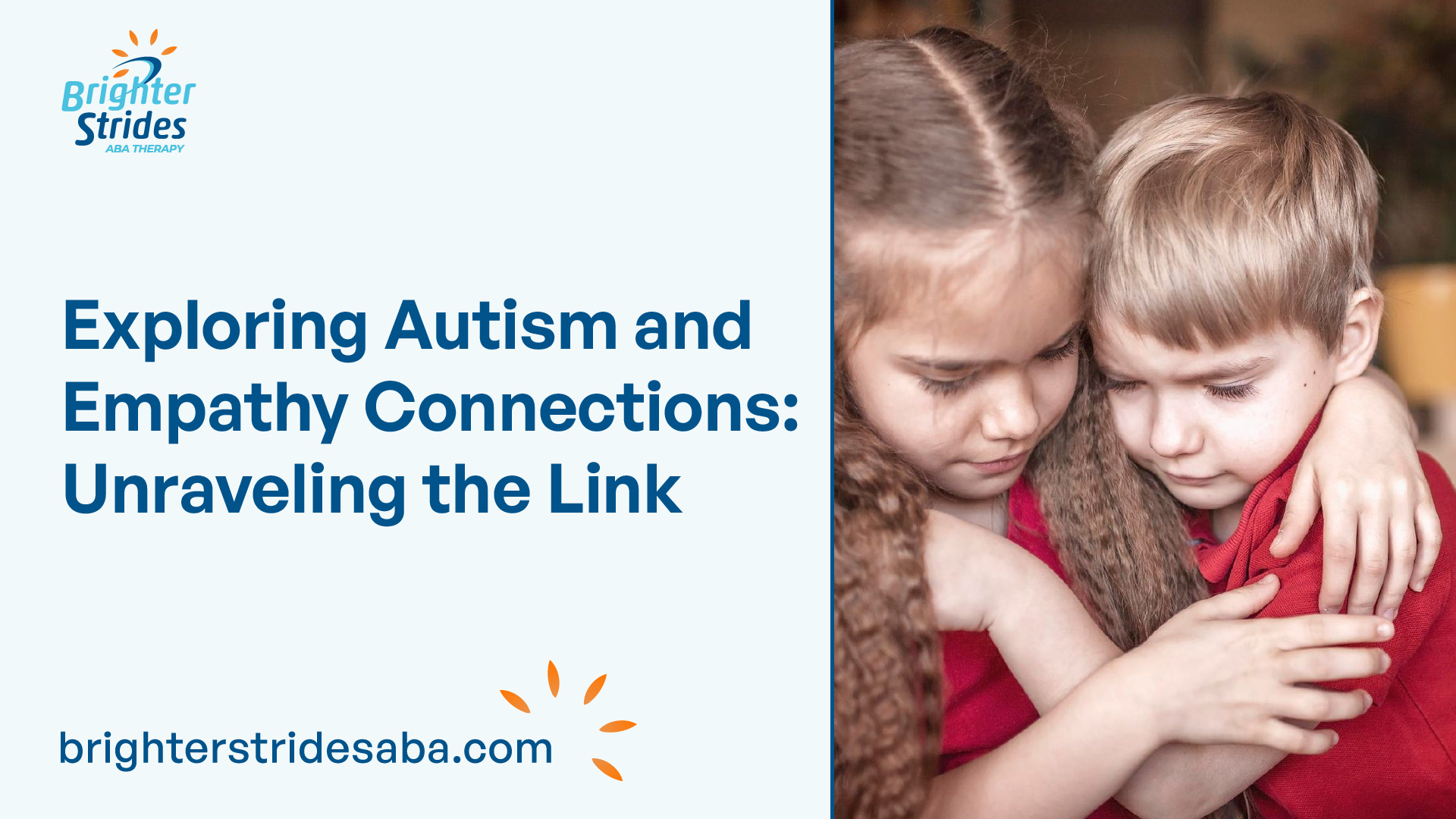Understanding Empathy in Autism
Empathy, the ability to understand and share the feelings of others, is a complex aspect of human interaction. When it comes to autism, there is a range of perspectives on empathy and its connection to the condition.
Empathy in Neurotypical Individuals
In neurotypical individuals, empathy plays a crucial role in social communication and understanding. It involves recognizing and interpreting emotional cues, both verbal and nonverbal, to comprehend the feelings and experiences of others. Neurotypical individuals can often instinctively identify and respond to these cues, facilitating effective social interactions.

Empathy Challenges in Autism
For individuals on the autism spectrum, the relationship between empathy and the condition is multifaceted. Research suggests that rather than lacking empathy, autistic individuals may have imbalances in empathy skills compared with neurotypical individuals due to difficulties with communication and interaction [1].
Autistic individuals may face challenges in identifying emotional behavior in others and interpreting nonverbal social cues, leading to difficulties in recognizing and understanding emotions. For example, they may struggle to discern whether someone is crying due to happiness or sadness [1]. These difficulties in recognizing emotional cues can impact their ability to empathize with others.
It is important to note that autistic individuals may not always adhere to the same social norms as neurotypical individuals. This can result in misperceptions of their empathetic abilities. Their differences in behavior and communication should not be mistaken as a lack of empathy. Autism-related social challenges may stem from sensory overload rather than a fundamental absence of empathy.
The relationship between autism and empathy is complex, and levels of empathy can vary among autistic individuals, similar to neurotypical individuals. Research suggests that autism-related social difficulties may be influenced by sensory overload rather than a lack of empathy. Other factors that can impact empathy levels in autism include alexithymia, a personality trait associated with difficulty expressing or identifying emotions, and gender differences in empathetic abilities.
Understanding the nuances of empathy in autism is essential to foster a more inclusive and empathetic society. It is crucial to recognize and appreciate the unique ways in which individuals on the autism spectrum experience and express empathy.
Factors Influencing Empathy in Autism
Empathy, the ability to understand and share the feelings of others, can vary among individuals with autism due to various factors. Understanding these factors is crucial in unraveling the link between autism and empathy. Let’s explore three key factors that influence empathy in autism: social cues and nonverbal communication, theory of mind, and sensory overload.
Social Cues and Nonverbal Communication
Autistic individuals may experience challenges in recognizing and interpreting social cues and nonverbal communication, which can impact their ability to understand the emotions of others. Research indicates that difficulties in identifying emotional behavior, such as interpreting nonverbal cues like facial expressions or gestures, can lead to misunderstandings in emotional situations. For example, they may have difficulty distinguishing whether someone is crying due to happiness or sadness.
To navigate social interactions effectively, autistic individuals may require explicit and direct communication, as relying on implicit social cues can be challenging. Understanding and interpreting social cues and nonverbal communication is an important aspect of empathy, as it helps individuals connect with and respond appropriately to the emotions of others.
Theory of Mind in Autism
Theory of mind refers to the ability to understand and attribute mental states, such as beliefs, intentions, and emotions, to oneself and others. Autistic individuals may experience difficulties in theory of mind, which can impact their empathetic understanding of others. This difficulty can lead to challenges in recognizing and understanding the emotions and perspectives of others.
According to Baron-Cohen’s theory of mind, impaired theory of mind is a central deficit in autism, and many symptoms characteristic of individuals on the autism spectrum can be explained by the inability to comprehend others. Difficulties in theory of mind can affect an individual’s ability to empathize with others by hindering their understanding of others’ thoughts, feelings, and experiences.
Sensory Overload and Empathy
Sensory overload refers to the overwhelming experience of excessive sensory stimuli that can occur in autistic individuals. Research suggests that social difficulties in autism may stem from sensory overload rather than a lack of empathy. The “intense world theory” proposes that certain brain regions are overactive in autistic individuals, leading to sensory and information overload that can cause fear and anxiety in social situations.
Sensory overload can impact an individual’s ability to empathize with others by diverting attention and overwhelming cognitive resources. When individuals are overwhelmed by sensory stimuli, their capacity to process and respond to others’ emotions may be compromised.
Understanding the factors that influence empathy in autism, such as challenges with social cues and nonverbal communication, theory of mind difficulties, and sensory overload, can help inform interventions and support strategies to enhance empathetic abilities in autistic individuals. By addressing these factors, individuals with autism can develop a deeper understanding of others’ emotions and foster meaningful connections with those around them.
Variability in Empathy Levels
Empathy is a complex construct that can vary among individuals, including those with autism. Contrary to the stereotype that autistic individuals lack empathy, research has shown that the relationship between autism and empathy is multifaceted and nuanced. In this section, we will explore the variability in empathy levels within the autism population, as well as factors that contribute to this variability.
Individual Differences in Empathy
Autistic individuals exhibit a wide range of empathy levels, highlighting the importance of recognizing the individual differences within the autism spectrum. While some individuals may experience challenges in understanding and expressing empathy, others may display empathy in unique ways. For example, a 2019 study published in the journal Autism found that autistic individuals are more likely than the general population to express sympathy for objects, showcasing their capacity for empathy [4].
Alexithymia and Empathy
Around half of autistic individuals have alexithymia, a personality trait associated with difficulty expressing or identifying emotions. This trait can potentially lead to challenges with empathy and understanding emotions [1]. The presence of alexithymia in some autistic individuals can further contribute to the variability in their empathic responses.
Gender Differences in Empathy
Research has also explored gender differences in empathy within the autism population. It has been observed that autistic females tend to display higher levels of empathy compared to autistic males. However, it is important to note that this finding is not universally applicable to all individuals and that empathy levels can still vary widely within both genders.
Understanding the variability in empathy levels within the autism population is crucial for dispelling misconceptions and promoting a more accurate understanding of autism and empathy. It is essential to recognize and appreciate the diverse ways in which autistic individuals experience and express empathy. By acknowledging the individual differences and exploring the factors that influence empathy in autism, we can foster a more inclusive and empathetic society.
Cognitive vs. Affective Empathy
Empathy is a complex construct that can be divided into different components, including cognitive empathy and affective empathy. In the context of autism, these two forms of empathy can exhibit distinct patterns.
Cognitive Empathy Challenges
Cognitive empathy refers to the ability to understand and interpret the thoughts, feelings, and perspectives of others. Autistic individuals may experience challenges in this aspect of empathy, as they may have difficulties in gaining access to the intentions, beliefs, and emotions of other people. This can result in difficulties in accurately understanding and predicting the emotions and behaviors of others.
The atypical patterns of activation in brain regions related to self-referential emotional cognition, such as the medial prefrontal cortex (MPFC), contribute to the challenges in cognitive empathy experienced by autistic individuals. Reduced activation in the ventral MPFC and precuneus/posterior cingulate cortex (PCC) has been observed in individuals with autism compared to neurotypical individuals. These regions are associated with empathic abilities, as measured by the Empathy Quotient (EQ).
Affective Empathy Strengths
Contrary to the prevailing notion that autism is characterized by a lack of empathy, research indicates that autistic individuals have intact emotional (affective) empathy alongside reduced cognitive empathy. Affective empathy refers to the ability to emotionally resonate with others, experiencing similar emotional responses. Autistic individuals may exhibit strong and overwhelming affective empathy based on instincts and involuntary reactions to others’ emotions.
Newer research suggests that some autistic individuals may actually feel other people’s emotions more intensely, challenging the notion of a deficit in affective empathy. This heightened affective empathy can contribute to a deep emotional connection and understanding of others’ emotions among autistic individuals.
Empathy Towards Objects
Autistic individuals may have difficulty showing sympathy for others, but interestingly, they are more likely than the general population to express sympathy for objects. A 2019 study published in the journal Autism found that autistic individuals show a greater propensity for empathizing with and expressing sympathy towards objects. This unique manifestation of empathy highlights the variability and complexity of empathy in the autistic population.
Understanding the distinct patterns of cognitive and affective empathy in autism is crucial for promoting empathy development and fostering positive social interactions. By recognizing the strengths and challenges in empathy, interventions and support can be tailored to address the specific needs of autistic individuals.
Enhancing Empathy in Autism
Empathy is a fundamental aspect of social interaction, and individuals with autism may experience challenges in this area. However, there are strategies and techniques that can be employed to enhance empathy in individuals with autism and promote their understanding and connection with others.
Teaching Cognitive Empathy
Cognitive empathy, the ability to understand and interpret others’ emotions, can be taught to individuals with autism. Techniques such as modeling, prompting, and reinforcement have proven effective in teaching autistic individuals how to respond to others’ emotions with appropriate phrases, tone of voice, facial expressions, and gestures. By providing structured guidance and practice, individuals with autism can develop cognitive empathy skills and gain a better understanding of the emotions and experiences of those around them.
Promoting Perspective-Taking
Promoting perspective-taking is another strategy for enhancing empathy in individuals with autism. This involves encouraging individuals to imagine themselves in someone else’s shoes and understand their thoughts, feelings, and experiences. Perspective-taking exercises can help individuals with autism develop a deeper understanding of others’ perspectives and foster empathy. By practicing perspective-taking, individuals with autism can broaden their ability to empathize and connect with others on a deeper level.
Encouraging Emotional Expression
Creating a safe and supportive environment that encourages emotional expression is crucial for enhancing empathy in individuals with autism. By providing opportunities for individuals to express their own emotions, they can develop a foundation for recognizing and empathizing with the emotions of others. Through supportive interactions and validation of their own emotions, individuals with autism can gain a better understanding of the emotional experiences of others and develop a sense of empathy.
By employing these strategies, individuals with autism can enhance their empathetic abilities and improve their social interactions. It is important to remember that empathy impairment in individuals with autism can vary across different components, and while cognitive empathy may be impaired, other aspects of empathy, such as empathic accuracy, may be intact or even superior [7]. Understanding and addressing the specific needs of individuals with autism can contribute to their overall development and quality of life.
Neurological Perspectives on Empathy
Understanding the neurological underpinnings of empathy in individuals with autism spectrum disorders (ASD) provides valuable insights into the challenges they face in relating to and understanding the emotions of others. This section will explore the brain regions involved in empathy, emotional cognition in autism, and the cognitive resources utilized by individuals with ASD in the context of empathy.
Brain Regions and Empathy
Research has shown that individuals with ASD have difficulties in gaining access to the intentions, beliefs, and emotions of other people, which can result in impaired empathy. These difficulties are associated with atypical patterns of activation in certain brain regions, particularly the medial prefrontal cortex (MPFC) and other areas related to self-referential emotional cognition.
The MPFC plays a crucial role in empathy as it is strongly interconnected with emotion processing areas. Activation in the ventral MPFC is associated with emotional “contagion” and the sharing of other people’s emotions. This region provides the basis for one’s “emotional bond” with the emotions of others. Individuals with ASD may exhibit reduced activation in the ventral MPFC, leading to disturbances in empathy.
Additionally, the temporoparietal junction (TPJ) is involved in differentiating between oneself and other people. Abnormalities in this region may contribute to the diminished capacity of individuals with ASD to show contagious emotional responses. The TPJ is also part of the ventral attention network, which is responsible for directing attention from internal states to external stimuli. Individuals with ASD may require more attentional resources when processing emotional stimuli.
Emotional Cognition in Autism
The atypical patterns of activation in the MPFC and other brain regions related to emotional cognition contribute to the difficulties individuals with ASD experience in understanding and responding to the emotions of others. Activation in the ventral MPFC and precuneus/posterior cingulate cortex (PCC) positively correlates with empathic abilities in both individuals with ASD and neurotypical individuals. However, individuals with ASD show reduced activation in these regions compared to neurotypical individuals.
Cognitive Resources in Empathy
Individuals with ASD utilize different cognitive resources to evaluate and gain access to their own emotional states in response to the emotions expressed by others. They may rely on cognitive components of theory of mind (ToM) and action monitoring to understand and empathize with others. Additionally, individuals with ASD exhibit enhanced cognitive distinction between their own emotions and those expressed by facial stimuli, suggesting a heightened awareness of self and others in emotional contexts.
Understanding the neurological perspectives on empathy in individuals with autism provides valuable insights into the challenges they face in relating to and understanding the emotions of others. By further exploring these perspectives, researchers and professionals can develop strategies and interventions to enhance empathy and improve social interactions for individuals with ASD.
References
- https://www.medicalnewstoday.com/articles/do-autistic-people-have-empathy
- https://www.thetreetop.com/aba-therapy/autism-and-empathy/
- https://www.altogetherautism.org.nz/a-shift-in-perspective-empathy-and-autism/
- https://www.verywellhealth.com/do-people-with-autism-lack-empathy-259887
- https://www.ncbi.nlm.nih.gov/pmc/articles/PMC9804307/
- https://www.ncbi.nlm.nih.gov/pmc/articles/PMC3046624/
- https://www.ncbi.nlm.nih.gov/pmc/articles/PMC6794557/




